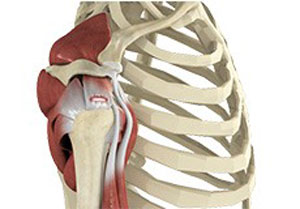
Introduction
The shoulder is a ball and socket joint made up of the scapula (shoulder blade), clavicle (collarbone), and humerus (upper arm bone). The scapula forms the socket while the head of the humerus forms the ball, enabling a full range of motion for the arm.
A group of four tendons and muscles called the rotator cuff maintain stability of the shoulder joint, preventing the humerus from sliding out of the socket bone (dislocation). The rotator cuff attaches the humerus to the shoulder blade and helps to lift and rotate your arm.
Rotator cuff tears can occur suddenly or gradually. When the rotator cuff is torn, pain, weakness and altered range of motion can result.
Causes
Trauma, degeneration, and aging can cause the rotator cuff to tear. A Rotator cuff tear is a common cause of shoulder pain and weakness in middle-aged and elderly people. However, it can occur at any age from injury.
Rotator cuff tears commonly occur from the following:
- Falling forward on an outstretched hand
- Lifting or pulling a heavy object
- Repetitive actions, especially those involving overhead hand movements such as swimming and tennis
- Bone spurs, an overgrowth of the shoulder bone
- Age: Degenerative changes over time can lead to a rotator cuff tear
Symptoms
Rotator cuff tears cause pain in the shoulder with swelling, weakness, tenderness, and altered range of motion.
Rotator cuff tears can be of two types: Partial or complete. With a partial tear, you will experience pain, but will still be able to move your arm. A complete tear involves detachment of the tendon from the humeral head and the inability to move the arm normally.
Diagnosis
When you visit your doctor with complaints of shoulder weakness and pain, your doctor analyzes your medical history and performs a thorough examination of your shoulder. Your doctor may order imaging tests such as X-rays, MRI, or ultrasound to confirm a diagnosis of rotator cuff tear. Sometimes, a shoulder arthrogram is performed, where a dye is injected into the shoulder joint and a series of X-ray images are taken.
Conservative Treatment
Non-surgical treatment of rotator cuff tears is initially recommended to alleviate pain and improve shoulder function. Your doctor may suggest the following measures:
- Rest the shoulder by placing your arm in a sling
- Pain medications
- Physical therapy to teach exercises to increase mobility and strength of the shoulder muscles
- Steroid and local anesthetic injections
Surgery
Surgery for a rotator cuff tear is advised when:
- Nonsurgical treatments do not improve symptoms
- Symptoms persist for six months to one year
- The tear is large (over 3 cm) or complete
- The condition restricts your activities, especially for professional sports players
- Loss of function and significant weakness is present
Rotator cuff repair involves stitching the torn tendon back onto its attachment to the arm bone (humerus).
Surgery for a rotator cuff tear can be performed through open or minimally invasive methods. The traditional open surgery involves a large incision over the shoulder, whereas the minimally invasive method involves 3 to 4 small incisions around the joint through which an arthroscope, a long, narrow instrument with a lens, light source, and camera attached to its end, is inserted.
The arthroscope provides a clear view of the surgical site which is displayed on a monitor for your surgeon to view. Small surgical instruments are introduced through the other incisions to perform the surgery and repair the damage.
- If the damage is a partial tear, the degenerative tissue of the tendon is cut out and removed along with any loose fragments (debridement), and the tear is left to heal on its own. Acromioplasty may be performed where the end of the acromion is reshaped to take pressure off the rotator cuff.
- If a bone spur is causing the tear, the spur is removed and the torn tendon is sutured.
- If the tear is complete, the degenerative tissue of the torn tendon is removed, and acromioplasty may be performed. The humeral bone head where the tendon was previously attached is cleansed and holes are drilled into the bone. Suture anchors are inserted and the tendons are sewn back to the anchors on the bone. Once repaired, the instruments are withdrawn and the incisions are closed.
The benefits of arthroscopy compared to the alternative, open shoulder surgery, include:
- Smaller incisions
- Minimal soft tissue trauma
- Less pain
- Faster healing time
- Lower infection rate
- Less scarring
- Earlier mobilization
- Usually performed as outpatient day surgery
Risks and Complications
As with any surgery, there are risks and complications that can occur.
Along with the risks of anesthesia, possible risks and complications associated with rotator cuff surgery include:
- Infection
- Bleeding
- Damage to nerves or blood vessels
- Blood clots (deep vein thrombosis)
- Stiffness
Summary
Rotator cuff tears are a common cause of shoulder pain in middle-aged and elderly people. They may occur from injury or degenerative changes that occur with aging.
Treatment depends on the severity of the tear. Rest, pain medications, and shoulder strengthening exercises may provide relief in cases of partial tears but complete tears may require surgery.
Surgery can provide relief from the pain in most cases, but recovering the functional mobility of the shoulder joint can vary from individual to individual and depends on active participation in post-surgical rehabilitation exercises.





